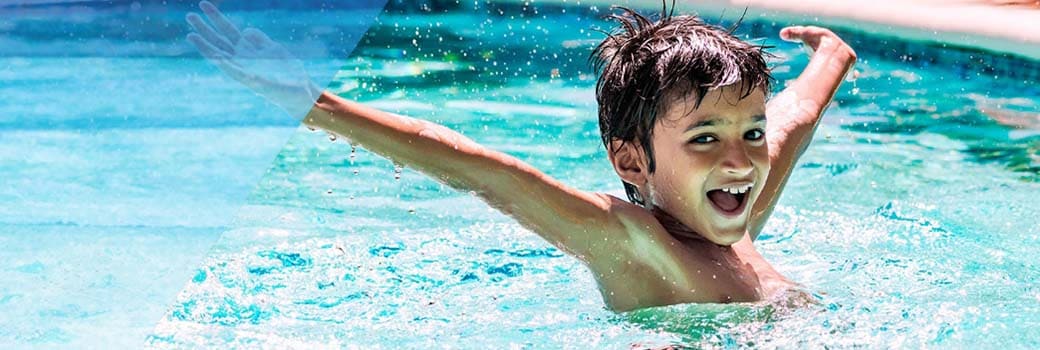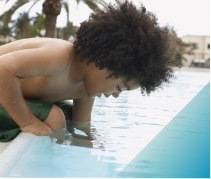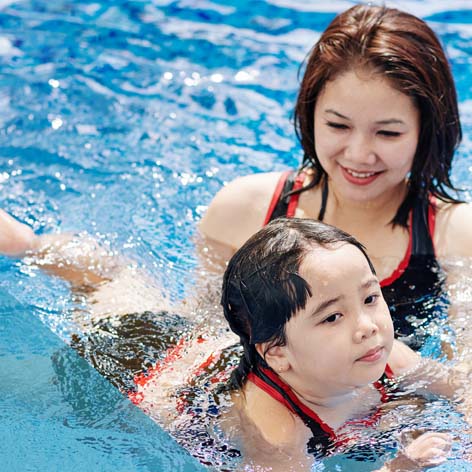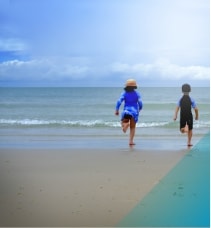Drowning Facts


In the United States:
- More children ages 1–4 die from drowning than any other cause of death.
- For children ages 5–14, drowning is the second leading cause of unintentional injury death after motor vehicle crashes.1
Every year in the United States there are an estimated:
- 4,000* fatal unintentional drownings—that is an average of 11 drowning deaths per day.
- 8,000† nonfatal drownings—that is an average of 22 nonfatal drownings per day.


- For every child under age 18 who dies from drowning, another 7 receive emergency department care for nonfatal drowning.1
- Nearly 40% of drownings treated in emergency departments require hospitalization or transfer for further care (compared with 10% for all unintentional injuries).1
- Drowning injuries can cause brain damage and other serious outcomes, including long-term disability.3-5
Drowning is the process of experiencing respiratory impairment from submersion or immersion in liquid. Drowning is not always fatal.
Fatal drowning happens when the drowning results in death.
Nonfatal drowning happens when a person survives a drowning incident. Nonfatal drowning has a range of outcomes, from no injuries to very serious injuries such as brain damage or permanent disability.
Children
Children ages 1–4 have the highest drowning rates. Most drownings in children 1–4 happen in swimming pools.2 Drowning can happen even when children are not expected to be near water, such as when they gain unsupervised access to pools. Fatal drowning is the leading cause of death for children 1-4 and the second leading cause of unintentional injury death for children 5-14, behind motor vehicle crashes.1
Males
Nearly 80% of people who die from drowning are male.1 Many factors might contribute to higher rates of drowning among males, including increased exposure to water, risk-taking behaviors, and alcohol use.6,7,8
Some racial and ethnic groups
Drowning death rates for American Indian or Alaska Native people ages 29 and younger are 2 times higher than the rates for White people, with the highest disparities among those ages 25-29 (rates 3.5 times higher).9,10 Drowning death rates for Black people are 1.5 times higher than the rates for White people. Disparities are highest among Black children ages 5-9 (rates 2.6 times higher) and ages 10-14 (rates 3.6 times higher).9
In swimming pools, Black children ages 10-14 years drown at rates 7.6 times higher than White children. Black children and youth are more likely to drown in public pools, and white children and youth are more likely to drown in residential pools.11 In natural water, American Indian or Alaska Native people have the highest drowning death rates, with rates 2.7 times higher than White people.9
People with seizure disorders or certain medical conditions
People with seizure disorders such as epilepsy are at a higher risk of fatal and nonfatal drowning than the general population. Drowning is the most common cause of unintentional injury death, with the bathtub being the most common site of drowning, for people with seizure disorders.7,12,13 Other conditions such as autism and heart conditions are associated with a higher risk of drowning.7,14-16
Not being able to swim
Many adults and children report that they can’t swim or that they are weak swimmers.17-19 Participation in formal swimming lessons can reduce the risk of drowning among children and young adults.7,20-23
Missing or ineffective fences around water
Proper pool fencing can prevent young children from gaining access to the pool area without caregivers’ awareness.7,23-25 A four-sided isolation fence which separates the pool area from the house and yard reduces a child’s risk of drowning by 83% compared to three-sided property-line fencing (which encloses the entire yard, but does not separate the pool from the house).26
Lack of close supervision
Drowning can happen quickly and quietly anywhere there is water, especially to unsupervised children. It happens in lakes and oceans, pools, bathtubs, and even buckets of water.7,27-29
Location
The highest risk locations for drowning vary by age. Among infants under 1 year old, two thirds of all drownings occur in bathtubs.2 Most drownings happen in home swimming pools among children ages 1–4.2 About 40% of drownings among children 5-14 occur in natural water, and about 30% occur in swimming pools.2 More than half of fatal and nonfatal drownings among people 15 years and older occur in natural waters like lakes, rivers, or oceans.2
Not wearing life jackets
Life jackets can prevent drowning during water activities, especially boating and swimming.7,31 The U.S. Coast Guard reported 658 boating-related deaths in 2021—81% died by drowning, and 83% of these people were not wearing life jackets.32
Drinking Alcohol
Among adolescents and adults, alcohol use is involved in:
- up to 70% of deaths associated with water recreation, like boating or swimming,
- nearly 1 in 4 emergency department visits for drowning, and
- about 1 in 5 reported boating deaths.2,32,33
Alcohol impairs balance, coordination, and judgment, and it increases risk-taking behavior.33
Using drugs and prescription medications
Certain medications can increase the risk of drowning, especially psychotropic medications commonly prescribed for depression, anxiety, bipolar disorder, schizophrenia, and other conditions.34 Side effects from these medications can be similar to the effects of alcohol, such as a difficulty thinking clearly and decreased motor skills.34 Other drugs and prescription medications might also increase drowning risk.35,36
*An average of 4,012 unintentional drowning deaths occurred each year from 2011–2020.2
† An average 8,061 estimated emergency department visits due to non-fatal drowning occurred each year from 2011–2020.1
- Centers for Disease Control and Prevention, National Center for Injury Prevention and Control. Web-based Injury Statistics Query and Reporting System (WISQARS). Accessed 10 August 2022.
- Centers for Disease Control and Prevention, National Center for Health Statistics. Wide-ranging Online Data for Epidemiologic Research (WONDER). Accessed 10 August 2022.
- Spack L, Gedeit R, Splaingard M, Havens PL. Failure of aggressive therapy to alter outcomes in pediatric near-drowning. Pediatric Emergency Care 1997;13(2):98–102.
- Suominen PK, Vähätalo R. Neurologic long term outcome after drowning in children. Scandinavian Journal of Trauma, Resuscitation and Emergency Medicine 2012;20(55):1–7.
- Suominen PK, Sutinen N, Valle S, Olkkola KT, Lönnqvist T. Neurocognitive long term follow-up study on drowned children. Resuscitation 2014;85(8):1059–106
- Lawes JC, Ellis A, Daw S, Strasiotto L. Risky business: a 15-year analysis of fatal coastal drowning of young male adults in Australia. Injury prevention 2021;27(5):442-559.
- Denny, Sarah A., Linda Quan, Julie Gilchrist, Tracy McCallin, Rohit Shenoi, Shabana Yusuf, Jeffrey Weiss, and Benjamin Hoffman. Prevention of drowning. Pediatrics 2021;148(2):e2021052227.
- Denny SA, Quan L, Gilchrist J, McCallin T, Shenoi R, Yusuf S, Hoffman B, Weiss J. American Academy of Pediatrics (AAP) – Council on Injury, Violence, and Poison Prevention. Policy Statement – Prevention of Drowning. Pediatrics 2019;143(5): e20190850
- Clemens T, Moreland B, Lee R. Persistent Racial/Ethnic Disparities in Fatal Unintentional Drowning Rates Among Persons Aged ≤29 Years – United States, 1999-2019. MMWR 2021;70(24):869-874.
- Gilchrist J, Parker EM. Racial/ethnic disparities in fatal unintentional drowning among persons aged ≤29 years—United States, 1999–2010. MMWR 2014;63(19):421–426.
- Saluja G, Brenner RA, Trumble AC, Smith GS, Schroeder T, Cox C. Swimming Pool Drownings Among US Residents Aged 5–24 Years: Understanding Racial/Ethnic Disparities. American Journal of Public Health 2006;96(4):728–733.
- Lhatoo SD, Sander JWAS. Cause-specific mortality in epilepsy. Epilepsia 2005;46(S11):36–39.
- Bell GS, Gaitatzis A, Bell CL, Johnson AL, Sander JW. Drowning in people with epilepsy – How great is the risk? Neurology 2008;71(8):578–582.
- Guan J, Li G. Injury Mortality in Individuals with Autism. American Journal of Public Health 2017;107(5):791–793.
- Guan J, Li G. Characteristics of unintentional drowning deaths in children with autism spectrum disorder. Injury Epidemiology 2017;4(32):1–4.
- Semple-Hess J, Campwala R. Pediatric submersion injuries: emergency care and resuscitation. Pediatric Emergency Medicine Practice 2014;11(6)1–22.
- Gilchrist J, Sacks JJ, Branche CM. Self-reported swimming ability in U.S. adults, 1994. Public Health Reports 2000;115(2–3):110–111.
- Irwin CC, Irwin RL, Ryan TD, Drayer J. Urban minority youth swimming (in)ability in the United States and associated demographic characteristics: toward a drowning prevention plan. Injury Prevention 2009;15(4):234–239.
- Pharr J, Irwin C, Layne T, Irwin R. Predictors of Swimming Ability among Children and Adolescents in the United State. Sports 2018;6(1):17.
- Brenner RA, Taneja GS, Haynie DL, Trumble AC, Qian C, Klinger RM, Klevanoff MA. Association between swimming lessons and drowning in childhood: A case-control study. Archives of Pediatrics & Adolescent Medicine 2009;163(3):203–210.
- Yang L, Nong QQ, Li CL, Feng QM, Lo SK. Risk factors for childhood drowning in rural regions of a developing country: a case–control study. Injury Prevention 2007;13(3):178–182.
- Petrass LA, Blitvich JD. Preventing adolescent drowning: Understanding water safety knowledge, attitudes and swimming ability. The effect of a short water safety intervention. Accident Analysis & Prevention 2014;70:188–194.
- Wallis BA, Watt K, Franklin RC, Taylor M, Nixon JW, Kimble RM. Interventions associated with drowning prevention in children and adolescents: systematic literature review. Injury Prevention 2015;21:195–204.
- World Health Organization (WHO). Preventing drowning: an implementation guide. Accessed 4 May 2021.
- U.S. Consumer Product Safety Commission (CPSC). Safety Barrier Guidelines for Residential Pools [PDF – 20 pages]. Accessed 16 April 2019.
- Thompson DC, Rivara FP. Pool fencing for preventing drowning of children. Cochrane Database of Systematic Reviews 1998;(1):CD001047.
- Quan L, Pilkey D, Gomez A, Bennett E. Analysis of paediatric drowning deaths in Washington State using the child death review (CDR) for surveillance: what CDR does and does not tell us about lethal drowning injury. Injury Prevention 2011;17:i28–i33.
- Petrass LA, Blitvich JD, Finch CF. Lack of caregiver supervision: a contributing factor in Australian unintentional child drowning deaths, 2000–2009. Medical Journal of Australia 2011;194(5):228–231.
- U.S. Consumer Product Safety Commission (CPSC). Submersions related to non-pool and non-spa products, 2011 Report [PDF – 10 pages]. Accessed 16 April 2019.
- Pelletier AR, Gilchrist J. Fatalities in swimming pools with lifeguards: USA, 2000-2008. Injury Prevention 2011;17(4):250–253.
- Cummings P, Mueller BA, Quan L. Association between wearing a personal floatation device and death by drowning among recreational boaters: a matched cohort analysis of United States Coast Guard data. Injury Prevention 2011;17(3):156–159.
- U.S. Coast Guard, U.S. Department of Homeland Security. Recreational Boating Statistics –2021 [PDF – 83 pages] Accessed 9 September 2022.
- Driscoll TR, Harrison JA, Steenkamp M. Review of the role of alcohol in drowning associated with recreational aquatic activity. Injury Prevention 2004;10(2):107–113.
- Pajunen T, Vuori E, Vincenzi FF, Lillsunde P, Smith G, Lunetta P. Unintentional drowning: Role of medicinal drugs and alcohol. BMC Public Health 2017;17(388):1–10.
- Ahlm K, Saveman B-I, Björnstig Ulf. Drowning deaths in Sweden with emphasis on the presence of alcohol and drugs – a retrospective study, 1992–2009. BMC Public Health 2013;13(216):1–10.
- Pearn JH, Peden AE, Franklin RC. The Influence of Alcohol and Drugs on Drowning among Victims of Senior Years. Safety 2019;5(1):1–10.